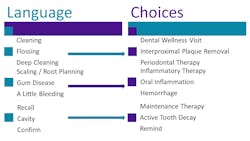Communication: The lifeline of dental practices
The lifeline of our dental practice is communication. Three pillars that conversations impact in dentistry are:
- Patients
- Players (team)
- Practice
We are in the midst of a shift from product centricity to people centricity, which requires a strong culture. Investments in our team members and patients are essential.
Patients
According to the Beryl Institute,1 the sum of every touchpoint before, during, and after the dental appointment impacts the patient experience. The institute defines patient experience as “the sum of all interactions, shaped by an organization’s culture, that influence patient perceptions across the continuum of care.”
These are four influencers of the patient experience:
- Interactions of people, processes, policies, communications, actions, and environment
- Culture—the vision, values, team, and community
- Perceptions—everything that is recognized, understood, and remembered by patients and support people
- Continuum of care—every interaction with a practice or provider before, during, and after delivery of care
Here are a few examples from each category as they relate to our dental practices.
Your dental team represents you. Do you know what they're saying?
Communication strategies to help disheartened parents try again
Interactions
- People: By using generational language and educational materials specific to patients’ values, we can establish trust and meet or exceed their expectations. For example, say you introduce an implant treatment case to a baby boomer. Consider having a paper brochure for them to take home to review after the appointment. Most Gen X/Y/Z patients will want electronic/digital resources.
- Communications: Consistent messaging and customized language for every team-to-patient interaction, insurance provider phone call, and referral connection are critical. Having specific processes and procedures in place that every team member knows, understands, and implements will not only impress your patients and referring offices, but it will also keep the follow-up process streamlined.
- Actions: Active listening is the act of mindfully hearing and attempting to comprehend the meaning of words spoken by another in a conversation or speech.
How well we listen has a major impact on our job effectiveness and the quality of our relationships with others. Active listening involves all our senses. We listen to obtain information, understand, enjoy, and learn. Given all the listening we do, you would think we would be good at it! But most of us are not.
Research suggests that we only remember 25%–50% percent of what we hear, as described by Edgar Dale's Cone of Experience.2 By becoming better listeners, we can improve our productivity, and our ability to influence, persuade and negotiate. What’s more, we can avoid conflict and misunderstandings.
Culture
- Include your entire team in the creation and continual pivoting of the practice mission statement and vision of the business strategy. This creates a sense of ownership, loyalty, and team dedication. Engaged employees will do far more than they are asked if they are invested in the practice.
- A safe sense of belonging and community is important to all team members. Recognizing and rewarding people for their efforts creates a positive, engaged culture that will work together for the good of the practice.
Perceptions
Perceptions vary according to the individual. If we look at our practice as if we were a new patient, referred by a trusted colleague, what would we see? I suggest you partner with a colleague and have a recon field trip at your next all-team meeting. Each team starts in the parking lot and walks through every experience the patient could have.
Here are a few areas to observe:
- Reception area
- Conversations overheard
- Patient bathroom
- Access to operatories
- Cleanliness/access
- Consultation area
- Marketing/product placement
Researchers from New York University found that we make 11 major decisions about one another in the first seven seconds of meeting someone. According to this study, the rest of our time is spent finding evidence to prove our original impression is correct whether the impression is true or not.3-5
The importance of creating good first impressions is immeasurable when it comes to patient perceptions. A first impression is a lasting impression.
Continuum of care
Look at the big picture of all the interactions the patient has with your practice.
- Have you answered all their questions?
- Have you provided resources and educational materials?
- Have you flagged them in your system to follow up?
- Did you provide referrals from happy patients who have completed similar treatment in your office?
- Have you provided financial assistance information?
- Did you give the patient a call to action (CTA)?
Team
When communication is not well defined or delivered, we become less impactful as a team.
A healthy practice requires proactive leadership, not by one person but by each team member at any given time. Team culture is driven from leading by example. Culture encompasses the tangible actions and beliefs of your team. It’s the pulse of your practice!
Understanding that leadership is bidirectional is the first step to creating a happy, engaged, and productive team. It links everyone together, no matter their role on the team, and it will produce these benefits:
- Reduce turnover: Individuals who feel appreciated for their knowledge support the practice.
- Improve team engagement: People will do more than asked if they feel valued.
- Increase production: A team working cohesively and sharing the load will be far more productive than individuals working in silos.
Practice
Your brand is more than the high-level procedures performed. It is systemic, and it trickles all the way down into the words we say and the communication tools we use. Your brand should speak the language of the patients you are trying to attract.
Every profession has its own language. Figure 1 provides examples of how we can level up our vocabulary to represent our brand and speak the patient’s language for better results. Language is our currency and a bridge to trust! Add this exercise to one of your team meeting agendas to create your office language together.
Conclusion
Communication is like cooking. You take individual ingredients and blend them together to create a delicious dish. The “ingredients” are the people we interact with—your patients, your team, your vendors, and your family. The “spices” are the way we customize the communication or the flavor. The end result—the delicious dish—is a harmonious, successful team and practice.
Editor’s note: This article first appeared in Through the Loupes newsletter, a publication of the Endeavor Business Media Dental Group. Read more articles and subscribe to Through the Loupes.
References
- Defining patient experience. The Beryl Institute. https://www.theberylinstitute.org/page/DefiningPatientExp
- Anderson HM. Dale’s cone of experience. Perspectives for Pharmacy Educators. Adapted from: Dale E. Audiovisual Methods in Teaching. Dryden Press; 1969. https://www.queensu.ca/teachingandlearning/modules/active/documents/Dales_Cone_of_Experience_summary.pdf
- Okten IO. Studying first impressions: what to consider? Association for Psychological Science. January 31, 2018. https://www.psychologicalscience.org/observer/studying-first-impressions-what-to-consider
- First impressions. Psychology Today. https://www.psychologytoday.com/us/basics/first-impressions#understanding-how-others-see-you
- Gibbons S. You and your business have 7 seconds to make a first impression: here’s how to succeed. Forbes. June 19, 2018. https://www.forbes.com/sites/serenitygibbons/2018/06/19/you-have-7-seconds-to-make-a-first-impression-heres-how-to-succeed/?sh=366e317e56c2
About the Author
Lisa Copeland, RDH, CSP, CVP
Lisa Copeland, RDH, CSP, CVP, is a certified speaking professional. Contact her at her website, Communicate With Influence, LLC.
Updated October 31, 2022


